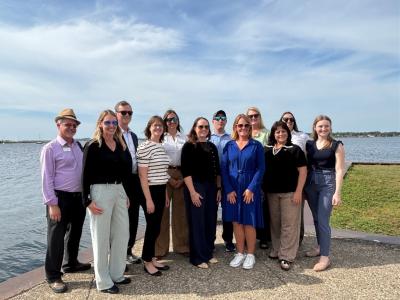Identifying the Great Lakes top ten most impactful aquatic invaders
iavilez
Mon, 04/21/2025 – 10:51 am
Invasive silver carp are not reproducing and overwintering in the Great Lakes – yet. Photo credit: Dan O’Keefe, Michigan Sea Grant.
A team of experts from NOAA, Michigan Sea Grant and the University of Michigan have identified the top 10 most impactful invaders based on analysis of almost 200 different nonnative aquatic species currently listed in the Great Lakes Aquatic Nonindigenous Species Information System (GLANSIS). This information system provides a “one-stop shop” for comprehensive information about each aquatic invader, which helps limit the introduction, spread, and impact of these harmful species.
GLANSIS is based out of NOAA’s Great Lakes Environmental Research Laboratory (GLERL) and is the Great Lakes hub for a national database of nonindigenous aquatic species. According to Acting GLERL Director Dr. Jesse Feyen, “GLERL experts have long studied the impacts of current and potential invaders in the Great Lakes. As the long-standing home for GLANSIS, our goal is to get the best available information out about the significant risks they pose to limit the introduction, spread, and impact of aquatic invasive species in the Great Lakes.”
With support from Congress through the Great Lakes Restoration Initiative, GLANSIS provides a comprehensive set of tools including species profiles, a custom-generated list of invaders, a mapping tool, risk assessments, and more. While GLANSIS was originally designed for use by scientists and environmental managers, this publicly accessible tool is used by local governments, property owners, anglers, teachers, students, and anyone who wants to learn more about stopping invasive species in the Great Lakes. Citizens and stakeholders can help protect their local waterways by learning how to recognize, report, and stop the spread of aquatic invasive species. GLANSIS also hosts data on “watchlist” species – plants, animals, and pathogens that have not yet established lasting populations in the Great Lakes but have been identified by experts as emerging threats. These include invasive silver and bighead carp, which have caused devastating ecological impacts to native fish and plants as they have expanded through other US waterways, as well as aquarium plants and pets like the self-cloning marbled crayfish, where even a single individual can launch a new invasive population.
The GLANSIS team recently brought together more than a dozen invasive species experts for a real-time virtual review to provide new data on more than 50 non-native species that are either already present in the Great Lakes basin or have been identified as one of these “watchlist species” that could be an emerging threat. These efforts ensure that the information in the database remains accurate, timely and relevant to environmental managers, educators, and other user groups who rely on GLANSIS for decision-making about aquatic invasive species.
Learn more about GLANSIS and explore the database yourself, or contact GLANSIS Program Manager Rochelle Sturtevant at: rochelle.sturtevant@noaa.gov.
Image
Mon, 04/21/2025 – 10:51 am
Keywords
invasive species
Great Lakes
Invasive silver carp are not reproducing and overwintering in the Great Lakes – yet. Photo credit: Dan O’Keefe, Michigan Sea Grant.
A team of experts from NOAA, Michigan Sea Grant and the University of Michigan have identified the top 10 most impactful invaders based on analysis of almost 200 different nonnative aquatic species currently listed in the Great Lakes Aquatic Nonindigenous Species Information System (GLANSIS). This information system provides a “one-stop shop” for comprehensive information about each aquatic invader, which helps limit the introduction, spread, and impact of these harmful species.
GLANSIS is based out of NOAA’s Great Lakes Environmental Research Laboratory (GLERL) and is the Great Lakes hub for a national database of nonindigenous aquatic species. According to Acting GLERL Director Dr. Jesse Feyen, “GLERL experts have long studied the impacts of current and potential invaders in the Great Lakes. As the long-standing home for GLANSIS, our goal is to get the best available information out about the significant risks they pose to limit the introduction, spread, and impact of aquatic invasive species in the Great Lakes.”
With support from Congress through the Great Lakes Restoration Initiative, GLANSIS provides a comprehensive set of tools including species profiles, a custom-generated list of invaders, a mapping tool, risk assessments, and more. While GLANSIS was originally designed for use by scientists and environmental managers, this publicly accessible tool is used by local governments, property owners, anglers, teachers, students, and anyone who wants to learn more about stopping invasive species in the Great Lakes. Citizens and stakeholders can help protect their local waterways by learning how to recognize, report, and stop the spread of aquatic invasive species. GLANSIS also hosts data on “watchlist” species – plants, animals, and pathogens that have not yet established lasting populations in the Great Lakes but have been identified by experts as emerging threats. These include invasive silver and bighead carp, which have caused devastating ecological impacts to native fish and plants as they have expanded through other US waterways, as well as aquarium plants and pets like the self-cloning marbled crayfish, where even a single individual can launch a new invasive population.
The GLANSIS team recently brought together more than a dozen invasive species experts for a real-time virtual review to provide new data on more than 50 non-native species that are either already present in the Great Lakes basin or have been identified as one of these “watchlist species” that could be an emerging threat. These efforts ensure that the information in the database remains accurate, timely and relevant to environmental managers, educators, and other user groups who rely on GLANSIS for decision-making about aquatic invasive species.
Learn more about GLANSIS and explore the database yourself, or contact GLANSIS Program Manager Rochelle Sturtevant at: rochelle.sturtevant@noaa.gov.
Image
Mon, 04/21/2025 – 10:51 am
Keywords
invasive species
Great Lakes








AOCs
Michigan
Remediation
Restoration